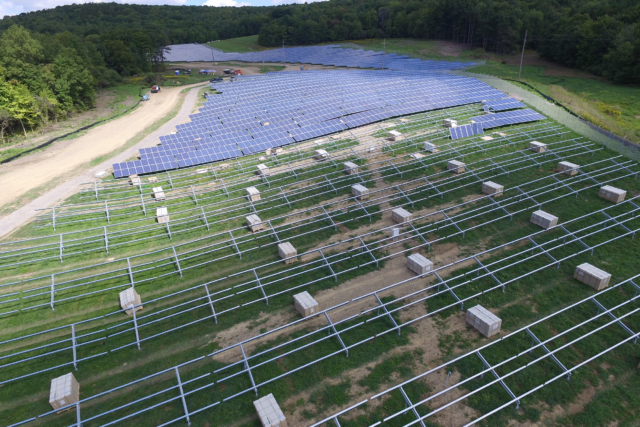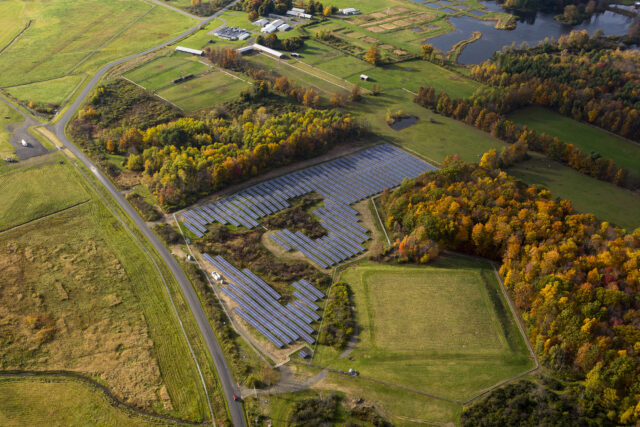Considering Solar – Rapid Solar Development Presents Municipalities With New and Important Considerations

Eyesores that ruin fields and woodlands, or an opportunity to produce renewable, decentralized energy?
Ten years ago, maybe the choice would have been clearer. As the result of benefit and incentive programs from New York State, the solar industry has taken on an entirely new set of advantages and considerations. Today, municipalities have some important decisions to make – and it’s not as simple as whether you’re pro- or anti-solar.
Throughout the last 15 years, solar development has skyrocketed around the US. As each state adopted its own laws in response to the growth, New York has seen the largest surge in the country – twice the national rate, according to the City University of New York (CUNY). As a result of New York’s incentive program, dubbed NY-Sun, the Empire State was home to 800% more solar energy in 2016 than in 2011.
NY-Sun is unique in that it doesn’t mandate solar onto any community, reflecting the New Yorkers’ varied opinions on the technology. It does, however, support the endeavor for those who seek it. Ironically, it’s NY-Sun’s flexibility that has made it so successful. Indicative of the state’s diverse array of geography, industry, and politics, New York State’s government decided that solar policy should fall on the shoulders of local leaders.
But whether your community wants to embrace solar energy or keep it at bay, it’s important to specify your community’s wishes through a solar ordinance or local law. By adopting local regulations, you can apply for tax programs and earn state credit, or prevent landowners from installing large solar farms in agricultural or historic districts. Either way, developing a solar ordinance will benefit your community.
Solar energy systems fit into one of two general categories: roof-mounted panels that supplement individual buildings, and large-scale solar farms that power substantial areas. Roof-mounted systems are typically permitted in all zoning districts and restrictions like height, setback, and aesthetic factors are outlined individually within each district. These small projects typically offset energy costs but don’t make a profit.
Large-scale solar energy systems, or “solar farms,” are a different story. They can accrue capital and there’s a more complex process involved in their approval. Solar farms across the state have been subject to site plan review and have frequently been placed before the municipal zoning board of appeals for a special or conditional use permit, use variance, or a combination thereof. Solar developers have found themselves in front of not one, but two or three boards and multiple public hearings prior to obtaining building permits.
Developers may complain that there is no streamlined process for obtaining approvals, but municipalities find themselves in a catch-22. Do they categorize a solar farm as a permitted use under the existing zoning code, or prohibit them because they are not clearly listed as a permitted use? Or, do they issue a moratorium on solar farms until a new code is developed? One thing is certain – none of these options satisfies all involved parties. And, though a solar ordinance or local law can clearly outline the path for developers in your community (or heavily regulate it to discourage solar development), it’s critical to understand the various benefits and complex considerations that come with solar power.
Kathy Spencer, one of LaBella’s environmental impact experts, laid out some of the reasons investing in solar is a different consideration for every community. “One of my first exposures to it was a project that involved clearing more than forty acres of woodland,” she says. “From the environmental review perspective, the thought of cutting down a woodland to put up solar panels gave me pause.” She called the New York State Department of Environmental Conservation (NYSDEC) to inquire about regulations on clearing wooded areas for solar development, but no such prohibitions exist. “There aren’t really regulations that would encourage developers to find a space that’s already cleared,” she says. “Not that trees don’t grow back – they do. But how is the state going to walk that line?”
And how does the state walk that line? By empowering local governments to decide which policies work for their community. “Municipalities have to find a balance between what are the benefits from an alternative energy standpoint,” Kathy says, “versus what’s going to happen to the environment from the construction – and possible clearing of the land – for these solar panels?”
While some municipalities may have undeveloped, rolling hills or open spaces which they’re eager to fit with solar panels, other communities value every acre of agricultural land in their district. “Agricultural and historic districts are prioritized,” weighs Kathy, “so it’s an important consideration.”
Even then, however, it’s not as simple as it used to be – as technology has progressed, solar fields have become less invasive and are no longer considered a permanent alteration to land, like building a mall or a parking lot would be. In fact, according to LaBella engineer Steve Longway, installation of a solar system doesn’t even tear up the grass. “Original solar farms of the 1970s had big concrete bases,” he says. “They were pretty invasive. Now, everyone is going to noninvasive installation methods for these large farms.” Modern solar fields use screw piles that don’t require earth moving, and are easily removed. “Aside from a central duct bank for cables and concrete pads for inverters,” Steve says, “there’s essentially no environmental impact.”
In addition, New York State law mandates that developers are responsible for decommissioning solar farms, which are typically slated for a life of twenty years. That said, it’s in their best interest that systems are non-invasive and easy to un-install. “I like to call it the eject button,” Steve said. “If an owner decides to decommission a solar farm for some reason, it’ll take a couple months to disassemble – that’s a lot of nuts and bolts – but they can begin farming that land immediately.”
Despite different approaches, New Yorkers are united in their desire to develop cleaner energy, promote job growth, and preserve our state’s beautiful wilderness. Some communities believe solar is the answer, and others want to work towards a different solution.
Whatever lies ahead, LaBella is ready to help your municipality craft a solar ordinance to match your community values and protect its resources. LaBella’s Planning Division has model ordinances, planning tools, and most importantly, the expertise to facilitate the process from start to finish.

